|
Three Obelisks in the British Museum
|
|
|
| Present Site: | Great Russell Street, London N 51°31'09.9" (51.51942) W 0°07'37.0" (-0.126946) |
| 1&2. | Pharaoh: | Nectanebo II (Late Period, The 30th dynasty, Reigned 4 Century BC) |
| Measurement: | 2.74 meters high | |
| 3. | Pharaoh: | Hatshepsut (New Kingdom 18th Dynasty, Reigned 15 Century BC) |
| Measurement: | 1.65 meters high |
About the Site:
The British Museum is one of the greatest museum in the World, has more than 8 million collections, has opened in 18 Century. The current building completed in 1847, and after the British Library was separated in 1997, the building was largely renovated, and the "Great Court" (museum's inner courtyard covered by glass and frame) completed in 2000.
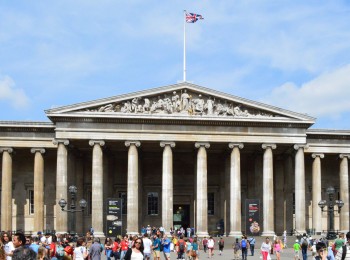 Facade of the Museum Facade of the Museum
|
How to Get There:
The Museum is in the center of London, but no underground station close to the museum. Although there are 4 stations: Russell Square, Goodge Street, Tottenham Court Road, and Holborn, but I would recommend Tottenham Court Road (Northern Line, Central Line), or Holborn (Central Line, Piccadilly Line) for the main entrance of the museum, about 300 meters by walk from the stations.
About the Obelisk:
Three (3) obelisks of Ancient Egypt and two (2) obelisks of Ancient Assyria are exhibited in this Museum.
Among three (3) of Ancient Egypt, two (2) are in the Great Court, along the wall of both side, that were made by King Nectanebo II. Another one (1) is in Room 65 (Sudan, Egypt and Nubia) on the Upper Level, that was made by Queen Hatshepsut.
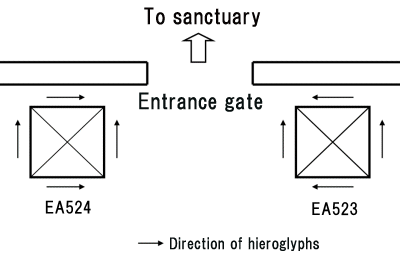 Estimated placement plan of Nectanebo II Obelisks |
1&2. Nectanebo II Obelisks
Both were made by Nectanebo II (Late Period, The 30th dynasty, Reigned 360-343 BC). The black siltstone (a kind of sedimentary rocks) is unusually used for these.
One (British Museum Collection EA523) was used as a material of fortress in Egypt, and found by British Tourist in 1737, and another one (British Museum Collection EA524) was found at the same site by Danish mathematician in 1762. Both were carried to Alexandria for transportation to France, but were captured with another antiquities such as famous "Rosetta Stone" by British Army since French Troops withdrew from Egypt.
It's uncertain for which temple these obelisks were erected because these were already carried into Cairo when they were discovered. But according to the explanation by the British Museum, the inscription of these obelisks says; these obelisks were dedicated to Thoth, the main god of Hermopolis [Ancient town along the Nile, about 250 km south of Cairo]. If so, these obelisks might be erected for the temple in Hermopolis.
The top of these obelisks are missing, and both are currently 2.74 meters high. The museum estimates it was originally about 5.5 meters high. The top portions are kept in the Egyptian Museum in Cairo, but not publicly exhibited.
The cartouche of coronation name and birth name of Nectanebo II are inscribed on the obelisk. Since the same texts are inscribed, we can assume both EA523 and A524 must be a pair. North face and south faces have, and west and east faces have same texts.
Because the cartouche is usually facing the gate (facing to the center) and facing the Holy of Holies (facing to the back), although I cannot definitely say since the upper portions are missing, but if the cartouche are facing the front, EA523 were right side of the gate and A524 were left side.
Reference: the Explanation by the British Museum
British Museum Collection EA523
This is exhibited at left side (Southwest Corner) of the Great Court entering from the main entrance.
British Museum Collection EA524
This is exhibited at right side (Northeast Corner) of the Great Court entering from the main entrance.
3. Hatshepsut Obelisk
I saw this obelisk in May 2015 when I revisied the Museum, although I overlooked it in Summer 2014. Room 65 on the Upper Level is a exhibition room for the unearthed articles from Sudan, Egypt and Nubia, and the obelisk is displayed with many other stone monuments.
According to the Museum's description, this obelisk was found at Qasr Ibri, between the First and Second cataracts in Nubia, but there is no clear evidence of building at Qasr Ibrim, so it could have been brought in from elsewhere. The obelisk is mabe by red granite with 1.65 meters high.
The inscription is engraved only on the front face, but the hieroglyph is unreadable due to the poor status of preservation.
The explanation for the museum exhibition says; "beloved of Horus, Load of Miam, living forever like Ra", but the name of Hatshepsut seems to have deleted later.
Miam is current Aniba, a town on the opposite side of Qasr Ibri, between the First and Second cataracts of Nile, about 250 km upstream from Aswan.
Reference: the Explanation by the British Museum
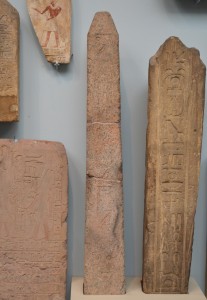
Front Side |
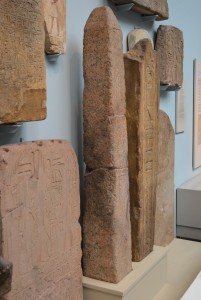
Left Side |
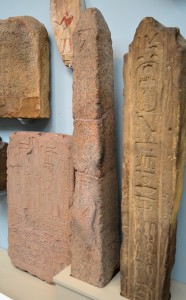
Right Side |
||
May 6, 2015 by Hiroyuki Nagase (For high definition image, please click the picture) | ||||
[Appendix] Assyrian Obelisk
Among five (5) obelisks in the British Museum, this would be the most wellknown, as a "Black Obelisk".
Wikipedia has a page for this Black Obelisk.
This was originally erected in 825 BC by Shalmaneser III, a king of Assyria [reigned 858-824 BC], and discovered in 1846 from underground of Nimrud (ancient Kalhu, Northern Iraq). This is 1.98 meters high, and has cuneiform inscriptions and the relief illustrated an image of Jehu, King of Israel who is contributing to King Shalmaneser, and the contributed animals.
Next to the "Black Obelisk", "White Obelisk" is also exhibited. This was discovered in 1853, and is 2.84 meters high. According to the Museum, the inscription may not have completed, and most are unreadable. The name of Ashurnasirpal is inscribed, but the researchers are still discussing whether Ashurnasirpal I [reigned 1050-1031 BC] or Ashurnasirpal II [reigned 883-859 BC].
Reference: the Explanation about Black Obelisk by the British Museum
Reference: the Explanation about White Obelisk by the British Museum
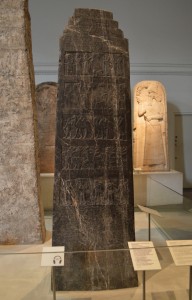 Black Obelisk |
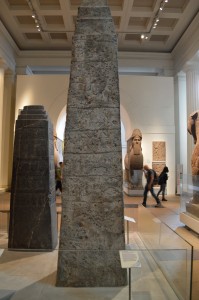 White Obelisk |
|
August 2, 2014 by Hiroyuki Nagase (For high definition image, please click the picture) | ||
Obelisks are not on display
The British Museum web site has a search service of the collections database. Checked the search results, it was found that there are following obelisks which are not on display.
There are such as a priest's obelisk in 4th century, and fragment of "Cleopatra's Needle".
| Object ID 111119 Museum number EA495 | Limestone obelisk inscribed with name of Iry, Lector-priest in Heliopolis. |
| Object ID 120829 Museum number EA693 | Sandstone obelisk; Hieroglyphic symbols on three sides; top chipped. |
| Object ID 120152 Museum number EA1205 | Black granite obelisk. |
| Object ID 125238 Museum number EA177 | Limestone truncated obelisk; two columns of incised Hieroglyphic text on each side, |
| Object ID 3358786 Museum number EA943 | Fragment of red granite from the obelisk of Tuthmosis III, known as "Cleopatra's Needle". |
| Object ID 177341 Museum number EA1727 | Pyramidion and upper part of shaft of a small obelisk, made of red granite, |
| Object ID 152637 Museum number EA65339 | Upper part of a red granite obelisk; the four sides are decorated with representations of Sety I(?). |
| Object ID 124686 Museum number EA1635 | Sandstone obelisk; decorative cross on the front in low relief beneath a panel of incised Coptic text. |
| Object ID 122801 Museum number EA1512 | Top of a limestone obelisk(?); Hieroglyphic text and representations of composite deities on each side. |
Copyright Hiroyuki Nagase nagase@obelisks.org and Shoji Okamoto okamoto@obelisks.org